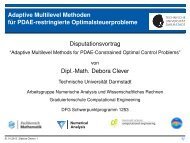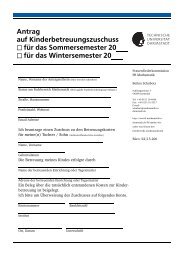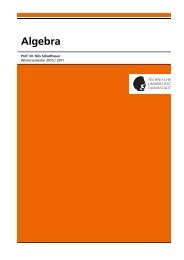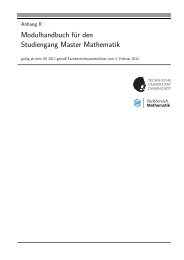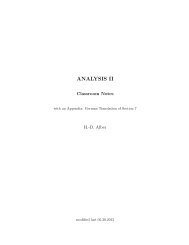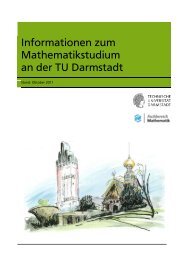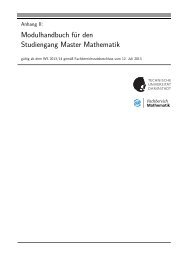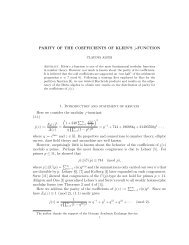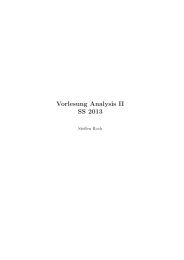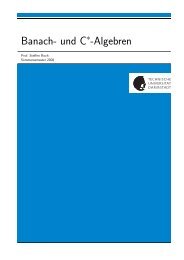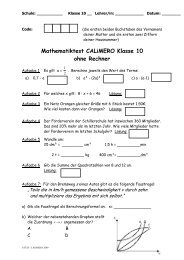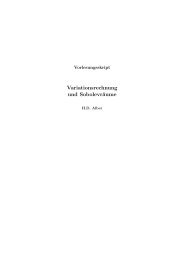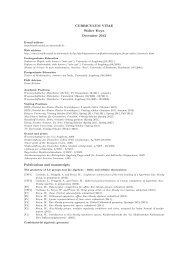Biannual Report - Fachbereich Mathematik - Technische Universität ...
Biannual Report - Fachbereich Mathematik - Technische Universität ...
Biannual Report - Fachbereich Mathematik - Technische Universität ...
You also want an ePaper? Increase the reach of your titles
YUMPU automatically turns print PDFs into web optimized ePapers that Google loves.
Poisson-Nernst-Planck equations, can only explain part of the experimental observations.<br />
Thus, in this project we will introduce new, nonlinear models including finite size effects.<br />
Continuing previous work, cf. [1, 2], we shall perform extensive numerical simulations and<br />
compare the results with experimental data from our collaborators, the Siwy research lab<br />
at the University of California, Irvine. In a second step, methods from the scope of inverse<br />
problem will be applied to reconstruct properties of the pore that cannot be observed<br />
experimentally. A prominent example is the surface charge inside the pore.<br />
Partner: German Academic Exchange Service (DAAD), PPP-Project<br />
Contact: J.-F. Pietschmann<br />
References<br />
[1] M. Burger, M. Di Francesco, J.-F. Pietschmann, and B. Schlake. Nonlinear cross-diffusion with<br />
size exclusion. SIAM Journal on Mathematical Analysis, 42(6):2842–2871, 2010.<br />
[2] M. Burger, P. A. Markowich, and J.-F. Pietschmann. Continuous limit of a crowd motion and<br />
herding model: analysis and numerical simulations. Kinet. Relat. Models, 4(4):1025–1047,<br />
2011.<br />
Project: Global Error Estimation for Finite Element Methods for Parabolic Differential<br />
Equations<br />
Modern solvers for partial differential equations of parabolic type gain in efficiency by<br />
adaptivly optimizing their grids based on local error control. However, the accuracy imposed<br />
by the user applies to the global error of the approximation. In this project we focus<br />
on efficient and reliable estimation and control of the global errors in finite element methods.<br />
We estimate the global errors by solving linearized error transport equations. For global<br />
error control we use the property of tolerance proportionality. Due to the stiffness of appearing<br />
subproblems in the method of lines our strategies are based on the concepts of<br />
B-stability and B-convergence.<br />
Partner: K. Debrabant (University of Southern Denmark, Odense)<br />
Contact: A. Rath, J. Lang<br />
References<br />
[1] K. Debrabant and J. Lang. On global error estimation and control of finite difference solutions<br />
for parabolic equations. ArXiv e-prints, 2009.<br />
Project: Unsteady Adaptive Stochastic Collocation Methods on Sparse Grids<br />
This project incorporates uncertain quantities arising in nature or processes into numerical<br />
simulations. By doing so, computational results become more realistic and meaningful.<br />
Underlying mathematical models often consist of Partial Differential Equations (PDEs)<br />
with input data, that specify the describing system. If these input parameters are not<br />
explicitly known or subject to natural fluctuations, we arrive at PDEs with random parameters.<br />
We focus on random parameters that can be described by correlated random fields.<br />
A parametrization into finitely many random variables yields problems with possibly high<br />
dimensional parameter space, that has to be discretized beside the deterministic dimensions.<br />
To this end, we use adaptive, anisotropic stochastic collocation on sparse grids.<br />
1.2 Research Groups 67



